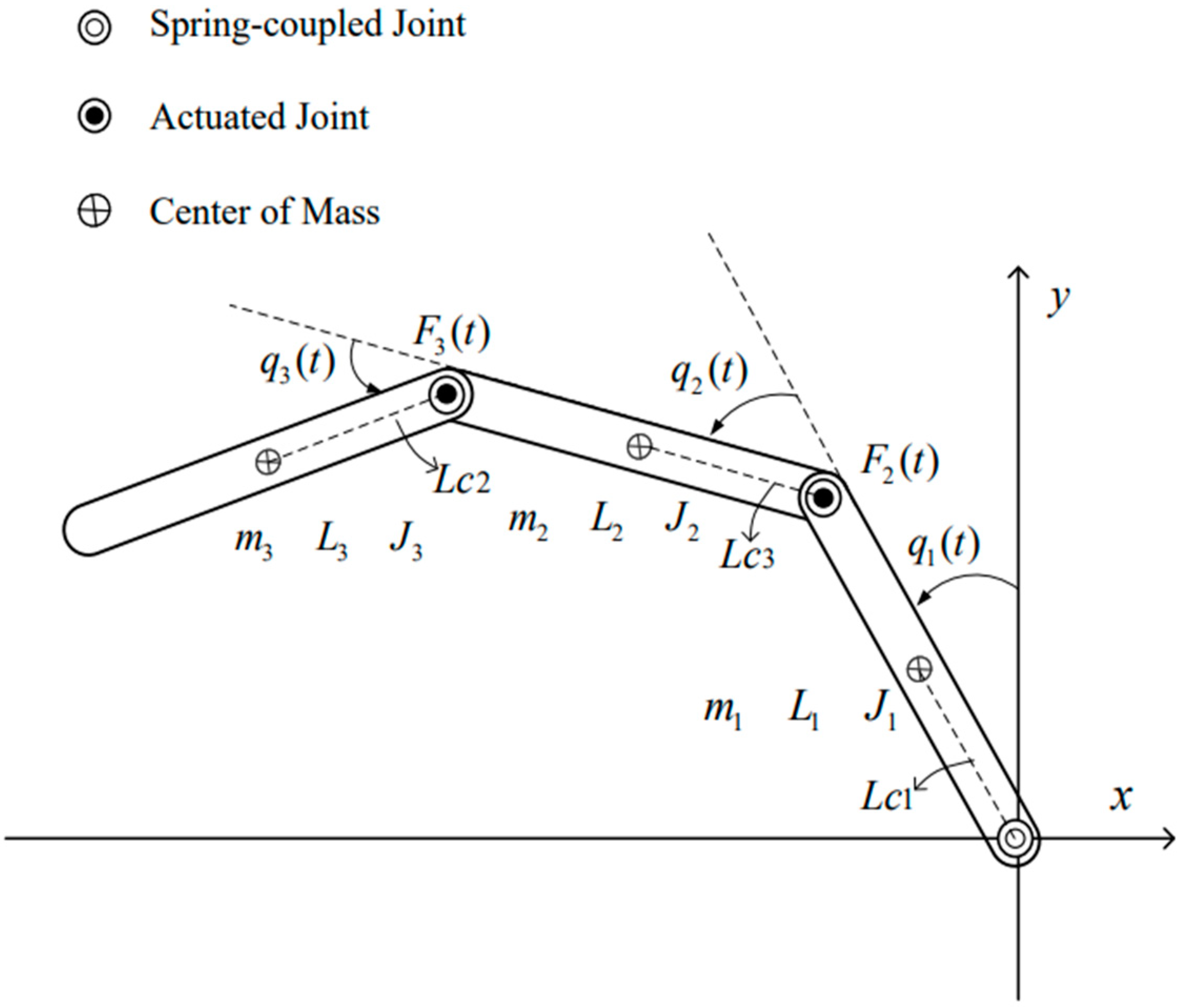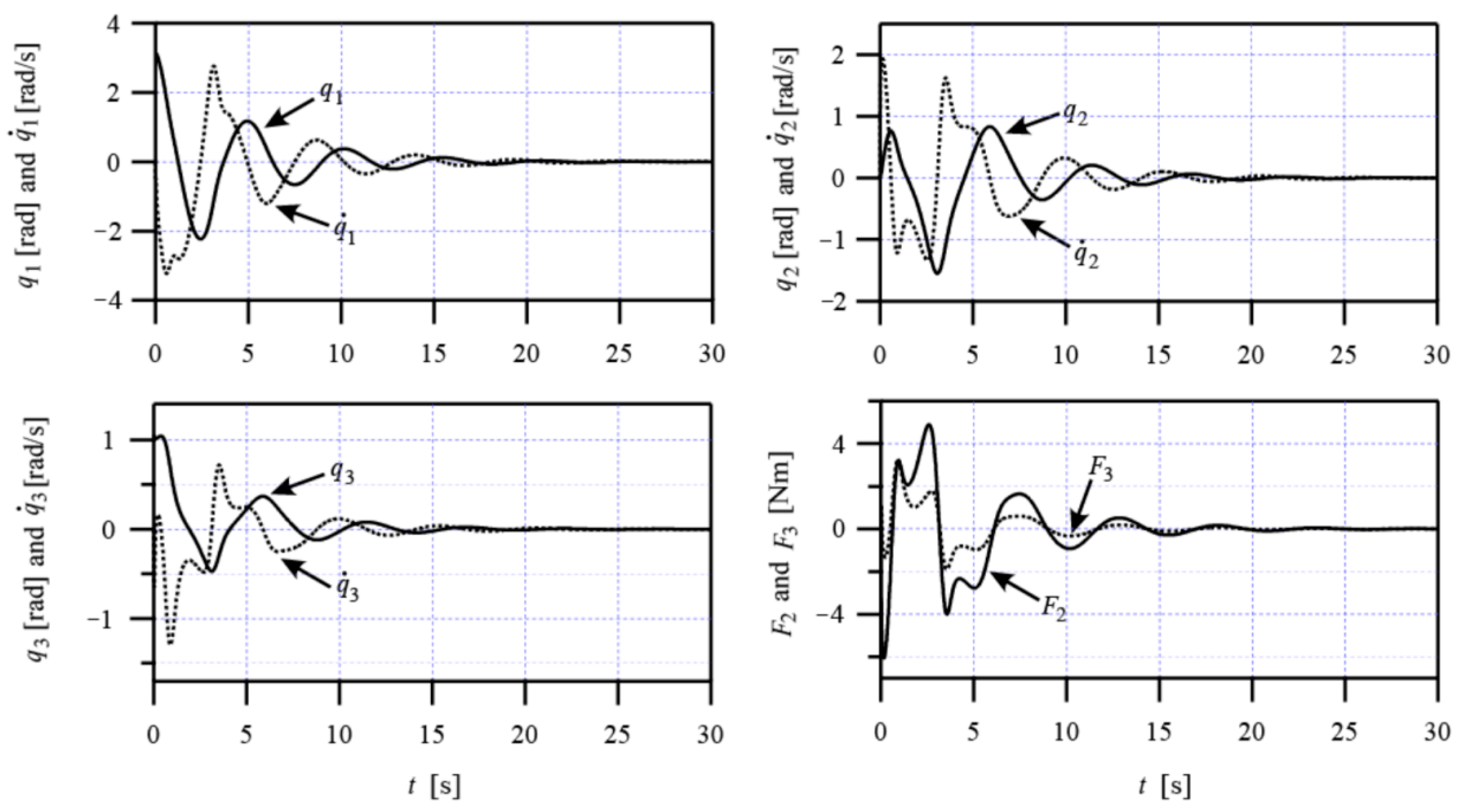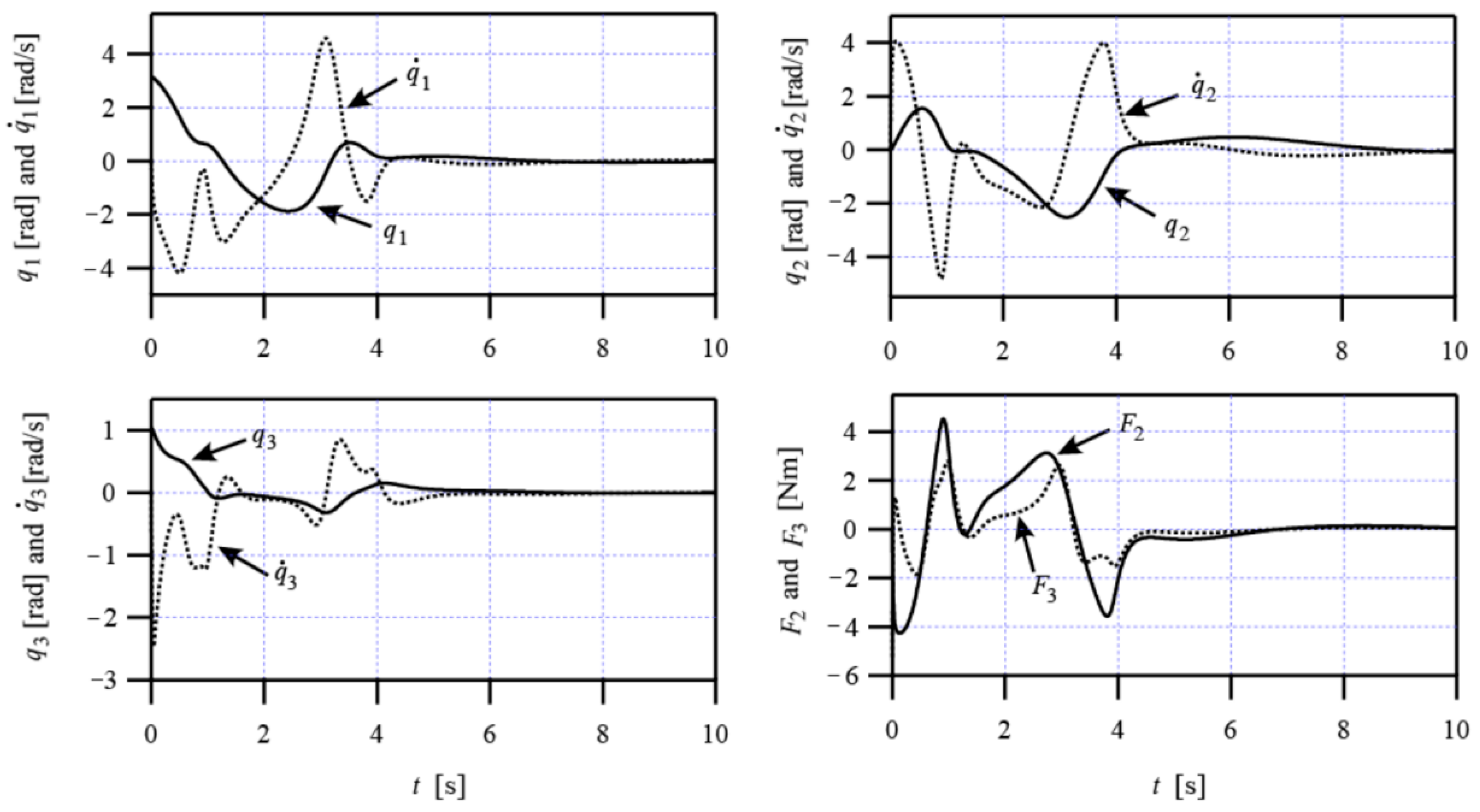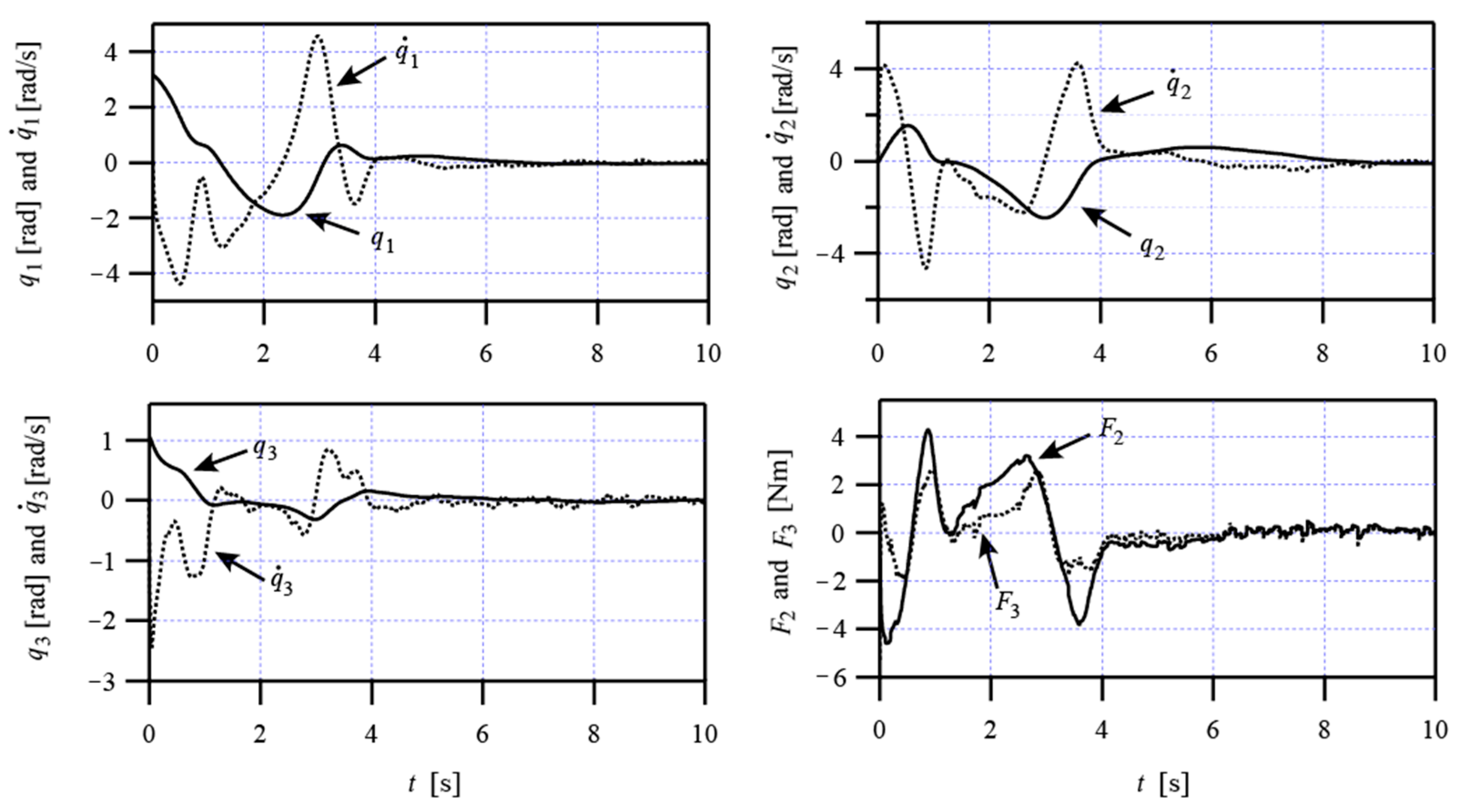Stabilization Control of Underactuated Spring-Coupled Three-Link Horizontal Manipulator Based on Energy Absorption Idea
Abstract
1. Introduction
2. Mathematical Model of Underactuated STHM System
- : mass of the link; : length of the link;
- : distance from a pivot joint to the center of mass (COM) of the link;
- : moment of inertia of the link; : the elastic coefficient of the spring;
- : rotation angle of the the link;
- : the input torque applied on the joint ().
3. Design of Virtual Friction Stabilizing Controllers
3.1. Design of PsD Controller
3.2. Design of PD Controller
4. Numerical Simulations
5. Conclusions
Author Contributions
Funding
Institutional Review Board Statement
Informed Consent Statement
Data Availability Statement
Conflicts of Interest
References
- Liu, Y.; Yu, H. A survey of underactuated mechanical systems. IET Control Theory Appl. 2013, 7, 921–935. [Google Scholar] [CrossRef]
- Oriolo, G.; Nakamura, Y. Control of mechanical systems with second-order nonholonomic constraints: Underactuated manipulators. In Proceedings of the 30th IEEE Conference on Decision and Control, Brighton, UK, 11–13 December 1991; pp. 2398–2403. [Google Scholar]
- Rudra, S.; Barai, R.; Maitra, M. Nonlinear state feedback controller design for underactuated mechanical system: A modified block backstepping approach. ISA Trans. 2014, 53, 317–326. [Google Scholar] [CrossRef] [PubMed]
- Huang, J.; Ri, S.; Fukuda, T.; Wang, Y. A disturbance observer based sliding mode control for a class of underactuated robotic system with mismatched uncertainties. IEEE Trans. Autom. Contr. 2019, 64, 2480–2487. [Google Scholar] [CrossRef]
- Xin, X. Nonlinear Swing down Control of the Acrobot—ScienceDirect. IFAC—PapersOnLine 2020, 53, 5813–5818. [Google Scholar] [CrossRef]
- Gonzalez, P.; Werner, H. Wide range stabilization of a Pendubot using quasi-LPV predictive control. IFAC—PapersOnLine 2019, 52, 164–169. [Google Scholar]
- Zhang, A.; She, J.; Qiu, J.; Yang, C.; Alsaadi, F. Design of motion trajectory and tracking control for underactuated cart-pendulum system. Int. J. Robust Nonlinear Control 2019, 29, 2458–2470. [Google Scholar] [CrossRef]
- Wu, X.; Xu, K.; Ma, M.; Ke, L. Output feedback control for an underactuated benchmark system with bounded torques. Asian J. Control 2021, 23, 1466–1475. [Google Scholar] [CrossRef]
- Iriarte, R.; Aguilar, L.T.; Fridman, L. Second order sliding mode tracking controller for inertia wheel pendulum. J. Frankl. Inst. 2013, 350, 92–106. [Google Scholar] [CrossRef]
- Li, Z.; Dixon, R. Robust non-minimal state feedback control for a Furuta pendulum with parametric modelling errors. IEEE Trans. Ind. Electron. 2020, 68, 7341–7349. [Google Scholar]
- Spong, M. The swing up control problem for the acrobot. IEEE Control Syst. Mag. 1995, 15, 49–55. [Google Scholar]
- Lai, X.; She, J.; Yang, S.; Wu, M. Comprehensive unified control strategy for underactuated two-link manipulators. IEEE Trans. Syst. Man Cybern. B (Cybern.) 2009, 39, 389–398. [Google Scholar] [PubMed]
- Yu, T.; Zhao, W.; Yang, K. Sliding mode variable structure control for a class of underactuated systems. Control Eng. 2019, 26, 1824–1829. (In Chinese) [Google Scholar]
- Moreno-Valenzuela, J.; Aguilar-Avelar, C.; Puga-Guzmán, S.; Santibáñez, V. Adaptive neural network control for the trajectory tracking of the Furuta pendulum. IEEE Trans. Cybern. 2016, 46, 3439–3452. [Google Scholar] [CrossRef] [PubMed]
- Xu, K.; Timmermann, J.; Trachtler, A. Swing-up of the moving double pendulum on a cart with simulation based LQR-Trees. IFAC—PapersOnLine 2017, 50, 4094–4100. [Google Scholar] [CrossRef]
- Sun, N.; Fang, Y.; Zhang, X. Energy coupling output feedback control of 4-DOF underactuated cranes with saturated inputs. Automatica 2013, 49, 1318–1325. [Google Scholar] [CrossRef]
- Lai, X.; Zhang, A.; She, J.; Wu, M. Motion control of underactuated three-link gymnast robot based on combination of energy and posture. IET Control Theory Appl. 2011, 5, 1484–1493. [Google Scholar] [CrossRef]
- Xin, X.; She, J.-H.; Yamasaki, T.; Liu, Y. Swing-up control based on virtual composite links for n-link underactuated robot with passive first joint. Automatica 2009, 45, 1986–1994. [Google Scholar] [CrossRef]
- Wu, J.; She, J.; Wang, Y.; Su, C.-Y. Position and posture control of planar four-link underactuated manipulator based on neural network model. IEEE Trans. Ind. Electron. 2019, 67, 4721–4728. [Google Scholar] [CrossRef]
- Mullhaupt, P.; Srinivasan, B.; Bonvin, D. Analysis of exclusively kinetic two-link underactuated mechanical systems. Automatica 2002, 38, 1565–1573. [Google Scholar] [CrossRef][Green Version]
- Zhang, A.; Lai, X.; Wu, M.; She, J. Global stabilization of underactuated spring-coupled three-link horizontal manipulator using position measurements only. Appl. Math. Model. 2015, 39, 1917–1928. [Google Scholar] [CrossRef]
- Zhang, A.; Lai, X.; Wu, M.; She, J. Nonlinear stabilizing control for a class of underactuated mechanical systems with multi degree of freedoms. Nonlinear Dyn. 2017, 89, 2241–2253. [Google Scholar] [CrossRef]




Publisher’s Note: MDPI stays neutral with regard to jurisdictional claims in published maps and institutional affiliations. |
© 2022 by the authors. Licensee MDPI, Basel, Switzerland. This article is an open access article distributed under the terms and conditions of the Creative Commons Attribution (CC BY) license (https://creativecommons.org/licenses/by/4.0/).
Share and Cite
Zhang, A.; Fan, L.; Gong, S.; Pan, G.; Wu, Y. Stabilization Control of Underactuated Spring-Coupled Three-Link Horizontal Manipulator Based on Energy Absorption Idea. Mathematics 2022, 10, 1832. https://doi.org/10.3390/math10111832
Zhang A, Fan L, Gong S, Pan G, Wu Y. Stabilization Control of Underactuated Spring-Coupled Three-Link Horizontal Manipulator Based on Energy Absorption Idea. Mathematics. 2022; 10(11):1832. https://doi.org/10.3390/math10111832
Chicago/Turabian StyleZhang, Ancai, Lu Fan, Shuli Gong, Guangyuan Pan, and Yinghua Wu. 2022. "Stabilization Control of Underactuated Spring-Coupled Three-Link Horizontal Manipulator Based on Energy Absorption Idea" Mathematics 10, no. 11: 1832. https://doi.org/10.3390/math10111832
APA StyleZhang, A., Fan, L., Gong, S., Pan, G., & Wu, Y. (2022). Stabilization Control of Underactuated Spring-Coupled Three-Link Horizontal Manipulator Based on Energy Absorption Idea. Mathematics, 10(11), 1832. https://doi.org/10.3390/math10111832





